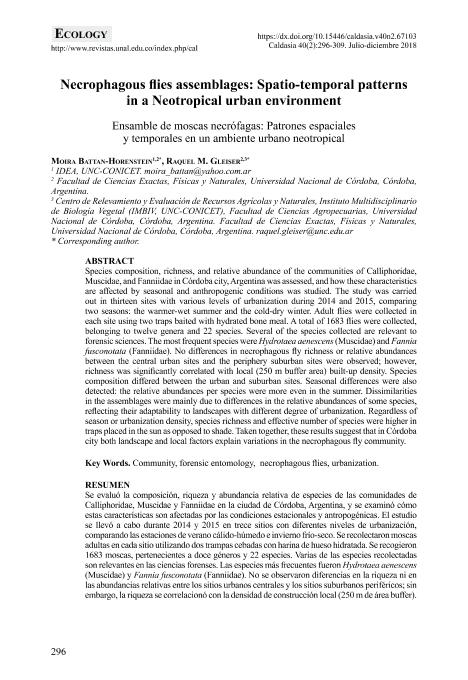Mostrar el registro sencillo del ítem
dc.contributor.author
Battan Horenstein, Moira

dc.contributor.author
Gleiser, Raquel M.

dc.date.available
2020-07-17T19:44:28Z
dc.date.issued
2018-12
dc.identifier.citation
Battan Horenstein, Moira; Gleiser, Raquel M.; Necrophagous flies assemblages: Spatio-temporal patterns in a Neotropical urban environment; Universidad Nacional de Colombia. Facultad de Ciencias. Instituto de Ciencias Naturales; Caldasia; 40; 2; 12-2018; 296-309
dc.identifier.issn
0366-5232
dc.identifier.uri
http://hdl.handle.net/11336/109584
dc.description.abstract
Species composition, richness, and relative abundance of the communities of Calliphoridae, Muscidae, and Fanniidae in Córdoba city, Argentina was assessed, and how these characteristics are affected by seasonal and anthropogenic conditions was studied. The study was carried out in thirteen sites with various levels of urbanization during 2014 and 2015, comparing two seasons: the warmer-wet summer and the cold-dry winter. Adult flies were collected in each site using two traps baited with hydrated bone meal. A total of 1683 flies were collected, belonging to twelve genera and 22 species. Several of the species collected are relevant to forensic sciences. The most frequent species were Hydrotaea aenescens (Muscidae) and Fannia fusconotata (Fanniidae). No differences in necrophagous fly richness or relative abundances between the central urban sites and the periphery suburban sites were observed; however, richness was significantly correlated with local (250 m buffer area) built-up density. Species composition differed between the urban and suburban sites. Seasonal differences were also detected: the relative abundances per species were more even in the summer. Dissimilarities in the assemblages were mainly due to differences in the relative abundances of some species, reflecting their adaptability to landscapes with different degree of urbanization. Regardless of season or urbanization density, species richness and effective number of species were higher in traps placed in the sun as opposed to shade. Taken together, these results suggest that in Córdoba city both landscape and local factors explain variations in the necrophagous fly community.
dc.format
application/pdf
dc.language.iso
eng
dc.publisher
Universidad Nacional de Colombia. Facultad de Ciencias. Instituto de Ciencias Naturales
dc.rights
info:eu-repo/semantics/openAccess
dc.rights.uri
https://creativecommons.org/licenses/by-nc-sa/2.5/ar/
dc.subject
COMMUNITY
dc.subject
FORENSIC ENTOMOLOGY
dc.subject
NECROPHAGOUS FLIES
dc.subject
URBANIZATION
dc.subject.classification
Ecología

dc.subject.classification
Ciencias Biológicas

dc.subject.classification
CIENCIAS NATURALES Y EXACTAS

dc.title
Necrophagous flies assemblages: Spatio-temporal patterns in a Neotropical urban environment
dc.type
info:eu-repo/semantics/article
dc.type
info:ar-repo/semantics/artículo
dc.type
info:eu-repo/semantics/publishedVersion
dc.date.updated
2020-07-13T16:09:07Z
dc.identifier.eissn
0366-5232
dc.journal.volume
40
dc.journal.number
2
dc.journal.pagination
296-309
dc.journal.pais
Colombia

dc.journal.ciudad
Bogota
dc.description.fil
Fil: Battan Horenstein, Moira. Consejo Nacional de Investigaciones Científicas y Técnicas. Centro Científico Tecnológico Conicet - Córdoba. Instituto de Diversidad y Ecología Animal. Universidad Nacional de Córdoba. Facultad de Ciencias Exactas Físicas y Naturales. Instituto de Diversidad y Ecología Animal; Argentina
dc.description.fil
Fil: Gleiser, Raquel M.. Consejo Nacional de Investigaciones Científicas y Técnicas. Centro Científico Tecnológico Conicet - Córdoba. Instituto Multidisciplinario de Biología Vegetal. Universidad Nacional de Córdoba. Facultad de Ciencias Exactas Físicas y Naturales. Instituto Multidisciplinario de Biología Vegetal; Argentina
dc.journal.title
Caldasia

dc.relation.alternativeid
info:eu-repo/semantics/altIdentifier/doi/https://dx.doi.org/10.15446/caldasia.v40n2.67103
Archivos asociados
